All About Cat Carriers
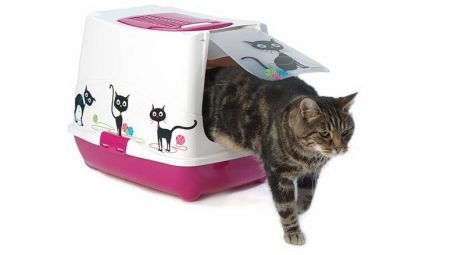
When traveling and during a car trip, during an air flight or in line to see a veterinarian, in a suburban train or at an exhibition, your pet needs a safe and secluded space that guarantees the protection of the pet from intrusive attention. The cat carrier is perfect for these tasks. Moreover, it is better to accustom a pet to it at the most tender age - babies adapt more easily to new conditions than adult animals.
But how do you choose a large carrier or a small bag? Is a backpack suitable for the animal or is it better to immediately purchase a container with a rigid frame? How to make a carrier bag for kittens with your own hands and what should be the dimensions of the cages on wheels? The answers to all these questions are very important and require the most detailed study. After all, when it comes to the comfort of a pet, there can be no trifles.
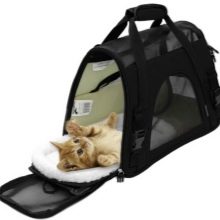
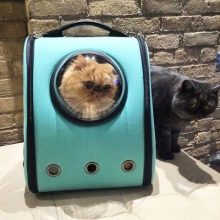
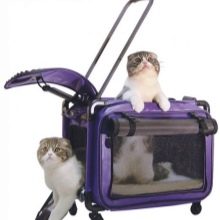
Appointment
A cat carrier is a simple design, but a very important device that every pet owner needs. According to its intended purpose, the structure can be suitable for long-term transportation - for several hours or days, as well as created for short-term use. In addition, it is very important to take into account the weight and dimensions of the pet - they affect the type of construction and some other features of carrying.
For a large-sized cat (over 5 kg in weight), you should choose a reliable plastic construction. For kittens, carriers are usually bought for growth, especially if more than one animal is to be transported, but several at once.Pets with abundant coat should choose well-ventilated cages, equipped with a special cover to create shade.
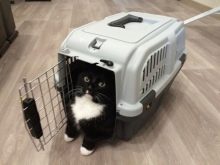
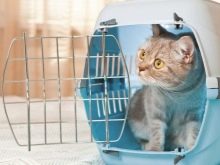
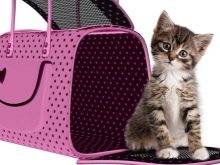
The main purpose of any carrier can be summed up in three key points.
- The calmness of the owner. Reliably closed from possible external influences, the pet does not pose a threat to others, is protected from infections, saved from the possible risk of escape, loss, death.
- Feeling safe for the animal. Cats are famous couch potatoes, they can hardly stand the change of circumstances around them and do not like to travel too much. Correctly selected carrier helps the animal to better endure the road, protects it from outside influences, unforeseen contacts.
- Satisfaction of physiological needs. The first and most important thing that the carrier gives is the feeling of a hard floor underfoot. In addition, a properly selected container allows the animal to be comfortably positioned within it. In the spacious carrier, you can allocate space for the toilet in the form of a hygienic absorbent diaper or tray with filler, install a drinker and a feeding bowl.
By observing all these points, you can ensure that any journey will be successful for the cat and will not cause psychological trauma.
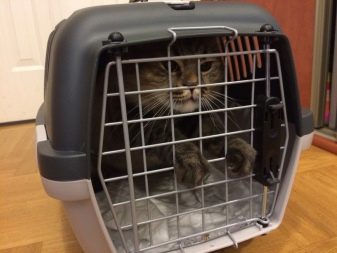
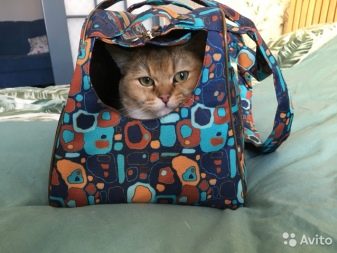
Views
Carrying is a convenient accessory, but choosing the best design option among the variety of options on sale can be difficult. Models on wheels and with handles, shoulder straps and shoulder straps, in the form of cages, baskets and bags - with such an assortment it is not difficult to get confused.
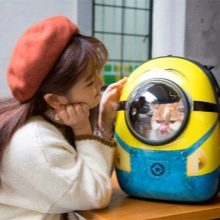

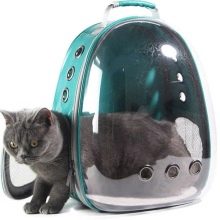
A bag
Classic designs with a light frame and fabric walls are most often created from synthetic, easily washable and hypoallergenic materials. The products are conveniently stored, can be washed or cleaned, and straps or handles are provided for carrying them.
It is important to take into account that bags are not intended for a long stay of the animal, and are poorly suited for large breeds of cats. In the absence of a rigid insert with a hard floor, the pet will experience serious discomfort. For winter operation, you will need an insulated model, otherwise the animal will get wet or freeze inside the product.
The obvious plus for bags is only one - a wide range of prices, which makes it possible to inexpensively purchase an optimal design. In addition, with a certain skill, you can sew such an accessory yourself.
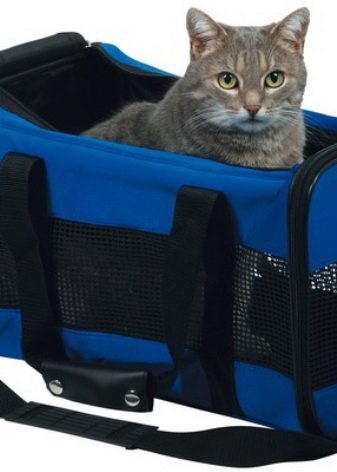
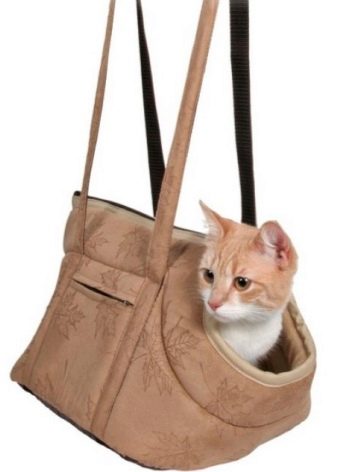
We should also consider frame bags-tents, in which the side walls unfold, forming a fairly roomy house. This design is convenient for traveling in a car or traveling to an exhibition, but it is difficult to maintain and takes up a lot of space.
Rolling bags are an option for active travelers. They have a retractable handle, rigid platform and rollers for movement.
It is important that the diameter of the wheels is rather large, there are additional compartments for supplying water and food.
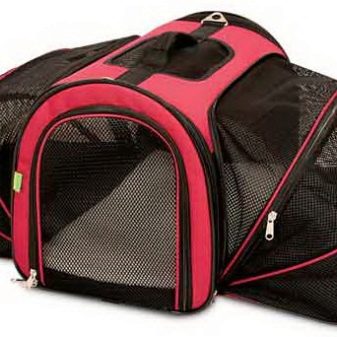

Cell
A metal cage is almost the only carrying option that you can take with you on an airplane. If we are talking about traveling in the passenger compartment, you only need to carefully measure the dimensions of the chosen design - they should not exceed 45x35x25 cm. If you go beyond these values, the animal will have to ride in the luggage compartment. Similar rules apply to cats weighing more than 8 kg.
For the duration of the trip, it is better to stock up on a special cover for the cage in order to save the pet from the annoying attention of others.
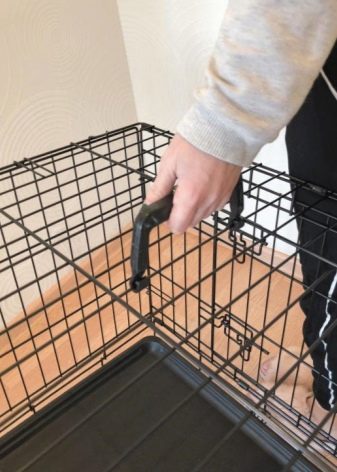
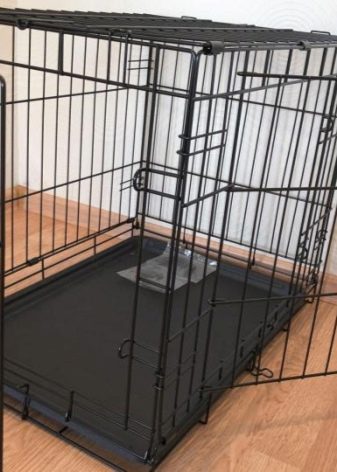
Metal lattice boxes are also convenient when transporting animals in a car. In addition to safety and good air exchange, the cage allows you to take care of the safety of the animal, because its rods make it possible to pass a seat belt through them.
For exhibitions and shows, this solution is also optimal, it allows you to provide a sufficiently high level of comfort and at the same time demonstrate the pet in all its glory. In addition, the use of cages can reduce the risk of the animal escaping in an unfamiliar place, and with the right cover, you can protect your pet from heat and other stressors.

Backpack
The most non-standard variant of a carrying bag is a shoulder backpack carried by the owner. Such products have a strong and rigid bottom, they can look like a sling for babies or a full-fledged spaceship capsule with a porthole. It is important to take into account the degree of sociability, the characteristics of the character of the pet. In addition, with this method of carrying, the animal may experience bouts of nausea, and the first appearance in the world is better done in a calm park or near the house.
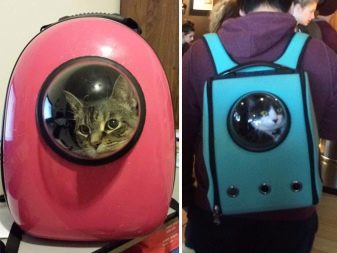
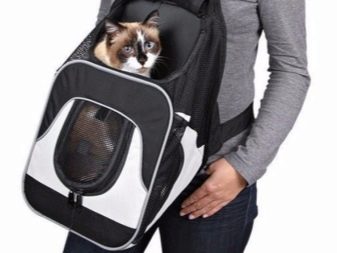
The convenience of the backpack is associated with the way it is carried - the load on the shoulders is distributed more evenly. But such an accessory is designed for small animals, and it is better to postpone a long trip. The animal will be ready to endure an uncomfortable position for 1-2 hours. When choosing a model, it is worth giving preference to solutions made of dense fabrics with air vents and a porthole for the pet to see the surroundings.
The rather high price and weight restrictions are the main disadvantages of carrying backpacks.
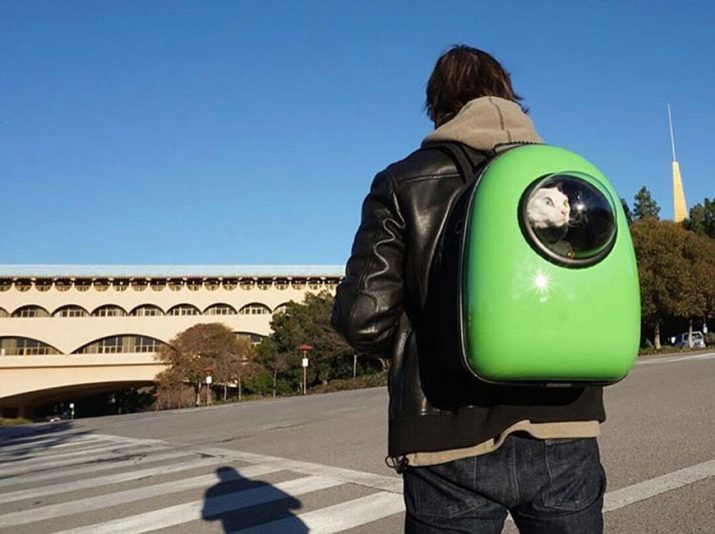
Boxing
A compromise solution is a plastic box, which is suitable for short-term trips, and for long journeys or even flights. A strong frame in this design is made of hypoallergenic plastic, ventilation holes are complemented by a lattice door, and inside there is enough space for one pet or even a cat with kittens to rest.

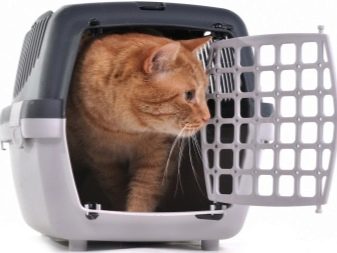
The hard floor of the container makes it possible to delimit its space by placing inside bowls with food, water, toilet, bedding for rest. A spacious temporary shelter gives cats a sense of security and helps them to move better. Many designs have a second bottom - for accessories, food, spare absorbent diapers.
Boxes are considered by owners to be the best choice for traveling and traveling with cats. But there are also disadvantages. The design turns out to be rather bulky, it is difficult and inconvenient to carry it by one handle.
If possible, it is worth choosing the option with a retractable handle, complemented by wheels like a suitcase.
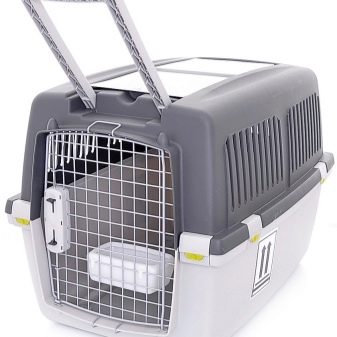
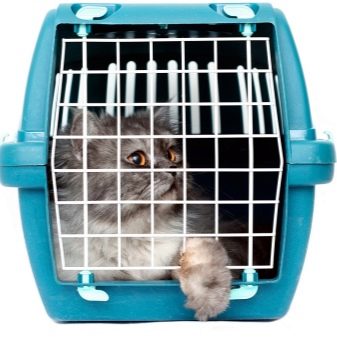
Basket
A real classic - the basket for carrying cats, made from natural vine or its plastic substitute. Such an accessory is distinguished by its low weight, structural strength, it has a hard bottom and a fairly spacious seating area. For the peace of mind of the owners, reliable latches and special locks are installed on products of this type. But the basket is not protected from precipitation, and in winter the pet will simply be cold in it.
Among the advantages of these accessories are good breathability, lightness, and affordable cost. Plastic models are easy to clean, suitable for road transport of the animal, trips to the country or to the veterinarian. The pet will be protected from prying eyes, will be able to comfortably sit inside.

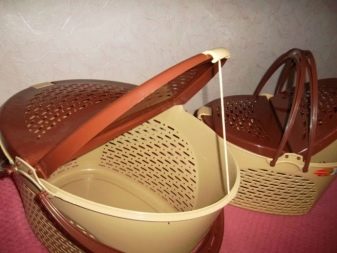
How to choose?
The need to find a suitable carrier for your pet appears even at the moment when the kitten is in its infancy. Visiting a veterinarian, going to the dacha or on vacation, visiting exhibitions is not complete without the use of a special temporary shelter.
It is believed that if you start learning to carry at an early age, there will be no problems with the further use of the box, bag or backpack.

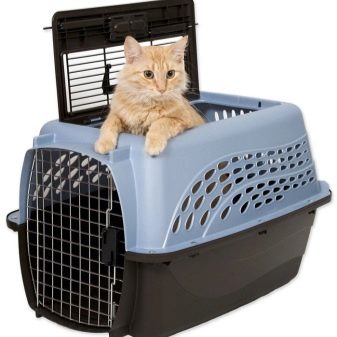
If there are more than one pets, then you can purchase models of bags for two cats at the same time. Mostly they look like soft tunnels with an arched top, inside which there is a detachable divider. By using a device for 2 cats that don't get along too well, they can be easily isolated... For friendly cats, it will be correct to remove the partition - they will become much calmer.
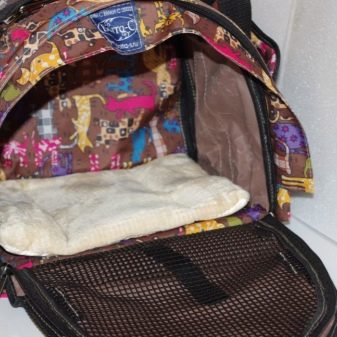
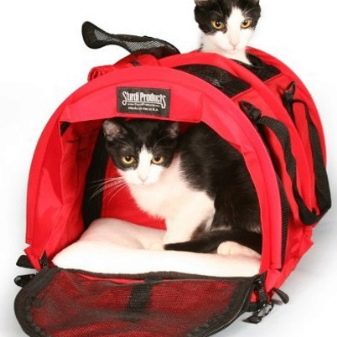
In addition to the number of places, it is worth paying attention to the following points during the selection of a carrier.
- The presence of a viewing window. Cats cannot tolerate tight and confined spaces in which they cannot control the situation. There will be much less panic if, during transportation, the animal is able to see the owner and survey the surroundings. In addition, fresh air also enters the carrier through the "windows" at the same time. They must be made of sturdy mesh, otherwise the viewing hole could be a trapdoor for escape.
- Construction type. If the carrier is not used too often, it would be wise to choose a folding type model, it is convenient to store it and you can take it with you if you have to pick up the animal from a shelter or hotel.
- Variety of mounts. The more straps, handles and other elements are in the base accessory set, the more room for maneuvers there will be when using the carrier. The straps make it easier to fix the cage or box in an airplane, car. Shoulder strap keeps your hands free.
Considering these moments, it is possible to easily solve even the most difficult problems and provide comfort for the animal and the owner during the movement.
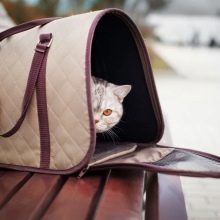
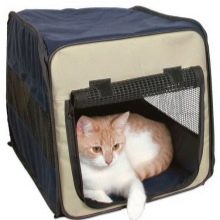
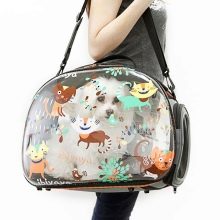
Dimensions (edit)
When choosing the size of the carrier for travel and travel in public or private transport, you need to focus solely on the size of the animal, breed characteristics and personal preferences of the owner. The cat should be free to sit and lie both along and across the selected container or cage. But if you plan to fly, much more stringent requirements will be imposed on the size range and design device. Among them:
- the total parameters of length, width and height should not exceed 115 cm (55x40x20 cm);
- free air access - no closed bags;
- with a mass of more than 8 kg, animals travel in the luggage compartment (weighed with a carrier).
If there are several animals, it is worth purchasing separate insulated boxes or a cage that can accommodate all pets at once.

The weight
Understanding what dimensions are acceptable for a particular method of transportation also helps to choose the right carrier. The use of any public transport assumes a closed type of container, preferably with a hard top. The size of the animal itself is also important. For large cats weighing more than 8 kg, it is worth choosing massive bags and boxes. The best choice would be products weighing about 3 kg, which are difficult to break or accidentally open; you can take a model on wheels so as not to carry heavy loads.
If the dimensions of the pet are less weighty, you can consider lightweight design options. For example, cats up to 5 kg are suitable for light bags, backpacks weighing no more than 1 kg.
It is important to choose a model that the animal does not overturn in a panic. The space inside the carrier should leave freedom of movement, provide the necessary protection.
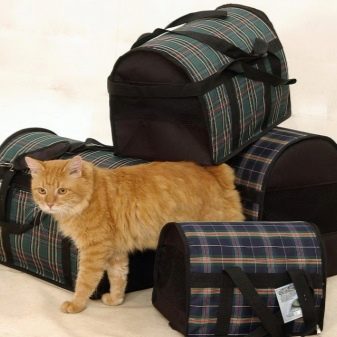
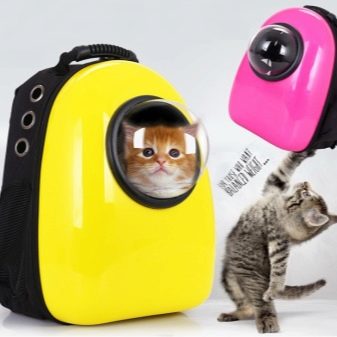
Materials (edit)
Based on the design features for the manufacture of carriers, they can be used the following materials.
- Textile... Soft cloth carrier is used for short-term transportation of the animal. Usually, easy-to-washable and moisture-proof fabrics with sufficient hygroscopicity are used. Insulated options are made for the winter season.
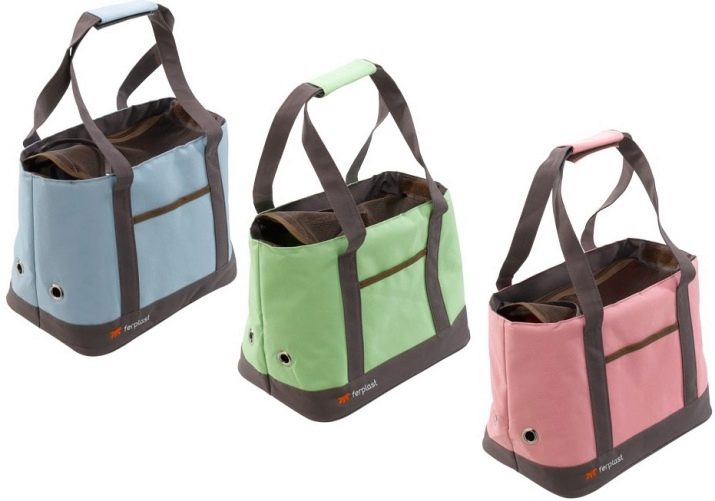
- Plastic... Rigid construction forms solid walls, allows for a washable bottom. This carrier can be washed, cleaned with safe chemicals. Inside, foam rubber mats are commonly used to provide warmth and comfort.
If you have a long trip or a whole day at the exhibition, the plastic "house" will be the best solution.

- Metal... It is used to make cages for air transportation, as well as exhibition structures to demonstrate the animal. Usually, chrome-plated products are used that are protected from corrosion, liners can be placed inside, providing comfort for the animal.
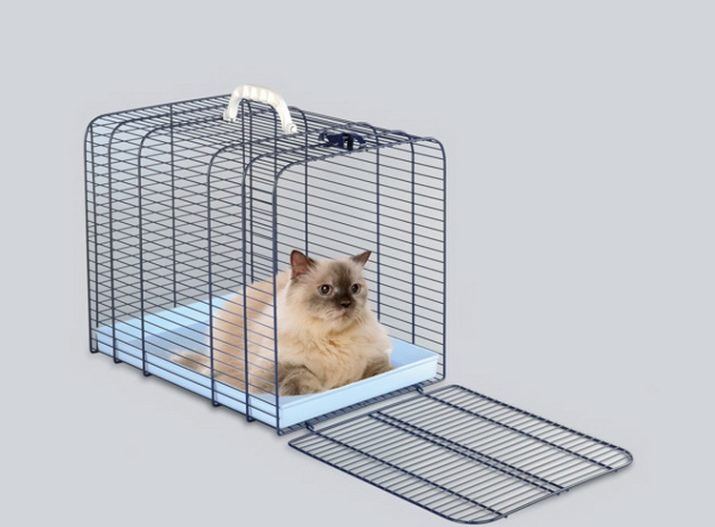
- Woody vine. Wicker products can have unusual shapes and sizes, they are environmentally friendly and provide good ventilation. But upon contact with odorous liquids or animal secretions, the vine absorbs them quite intensively, it is difficult to clean it.
Cats find such shelters quite comfortable, and the owners prefer this particular option for long journeys and trips.
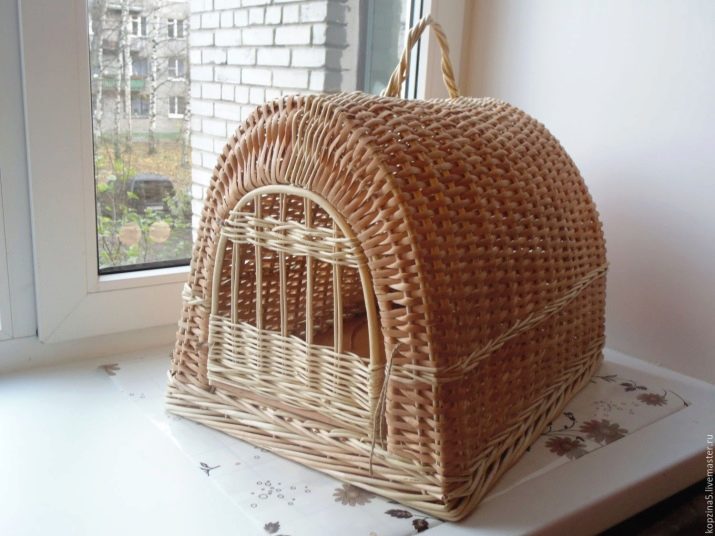
When choosing materials, one should give preference to solutions that are comfortable for the animal, focus on the method of transportation. Among the fabric models, you can pick up bright, attractive models that are quite spacious. It is convenient to select and various carrying options - you can find models with a shoulder strap, straps for carrying on the back or chest, with classic handles.
With a low quality of materials, polymer containers can have off-odors, in addition, they are rather bulky, not very suitable for long trips. But they have full ventilation holes to ensure sufficient air exchange, and the pet feels protected and less nervous.
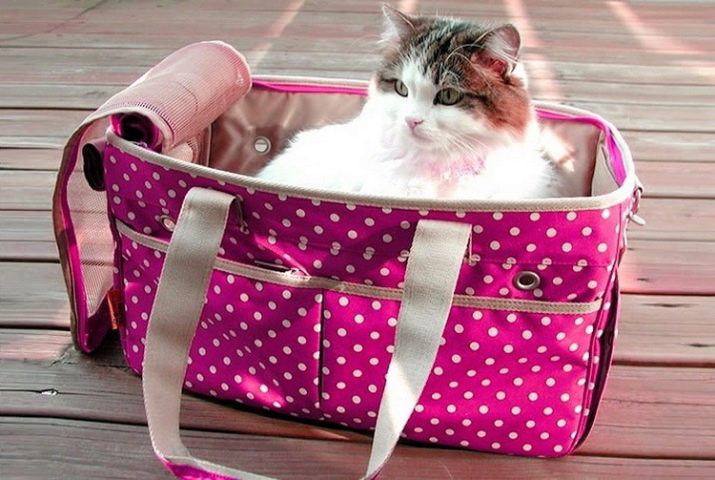
Season
If you have to use the carrier year-round, you should make sure that your pet is comfortable in it in any weather. For example, in soft bags for which winter operation is provided, removable liners in the walls are often made, allowing the accessory to be insulated in winter. Another option is an outer fur cover for a hard carrying.
For summer, it is better not to buy bags of black or dark color - they will heat up more than usual, which creates a risk of heat stroke for the animal. If possible, you should have your own version of carrying for each season - for example, a winter sling or a backpack can be hidden under the owner's jacket, sharing the warmth with your pet.
Then no cold weather will definitely be terrible for the animal.


How to care?
When transporting an animal, especially when it comes to a sick pet that needs veterinary care, the issue of removing specific biological contaminants is always especially acute. When multiple pets are using the same carrier, the infection can spread quite easily. In addition, you can stain a cage or container or a cloth bag from the outside, dirt and dust settle on them. The most difficult thing is with wicker products - they are rather difficult to process. Due to the nature of the weaving, a potential focus of infection can be missed.
The first and most important rule in using the carrier is that it should be regularly treated with hot steam, and the cloth covers should be washed at high temperatures. Plastic containers made of high-quality food grade polymers can be disinfected with boiling water. The fabric elements are also boiled. In veterinary medicine, chlorine disinfecting compounds are most often used for sanitation, but at home you can resort to chlorine-free options based on formalin, soda ash.


Among the drugs for medical purposes, "Virosan", "Glutex", "Ecocid S", "Virotsid" are recommended for use. The cage can be sprayed with an iodine solution, which is commercially available as a spray. When processing with antiseptics, it is worth leaving the formulations for exposure for 20-30 minutes, especially if there was contact with an infected animal. It is recommended to soak cloth products with an antiviral agent for a while.
As an additional disinfectant, quartz lamps can be used, which eliminate most of the microorganisms.They are especially convenient for the proportion of cattery owners, breeders containing more than one cat.


How to do it yourself?
The easiest way to carry it is quite possible to do it yourself. If you have to take a sick pet to the veterinarian or transport a kitten, you can create a temporary shelter literally from scrap materials - out of the box (a cardboard one with high sides will do), gluing its seams with adhesive tape. A blanket bedding or a soft mattress is placed on the improvised "floor".
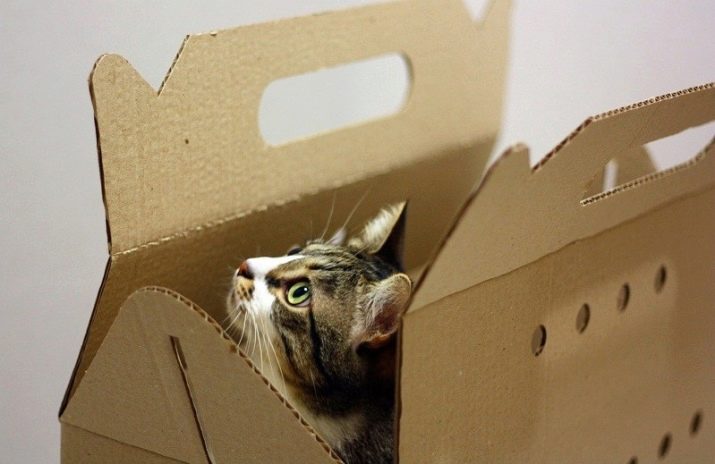
A fabric travel bag is also easy to create. It is enough to follow simple instructions.
- Pick up materials. Any thick fabric will do, from tarps to drapes to jeans. To form a hard bottom, thick cardboard or plastic is used, you can take the bottom from an old sports bag as a base. You will also need tailor's scissors, chalk, a sewing machine, threads and accessories. It is recommended to choose a mesh cover for one of the sidewalls.
- Build a pattern. The simplest form is a triangle or a quadrangle. One of the sidewalls should be detachable, with a sewn-in zipper, the second - with a mesh for air flow (a strong mosquito with metallization is suitable). The base has the largest area; a cover is sewn for it, to which the rest of the parts are attached. The dimensions of the elements should allow the animal to be freely positioned horizontally and vertically inside.
- Using a typewriter, you should connect all the parts starting from the bottom, into which the prepared rigid frame is inserted. For winter, you can insulate the floor and walls, make them with fur or replace it with padding polyester. Next, it remains to collect the parts together and sew in the fastener, add accessories.
- Attach the carrying strap or handles to the sewn structure. It is worth using a shoulder strap - it is the most convenient to use, it allows you to make the transportation process less uncomfortable. Check all connections for tightness.
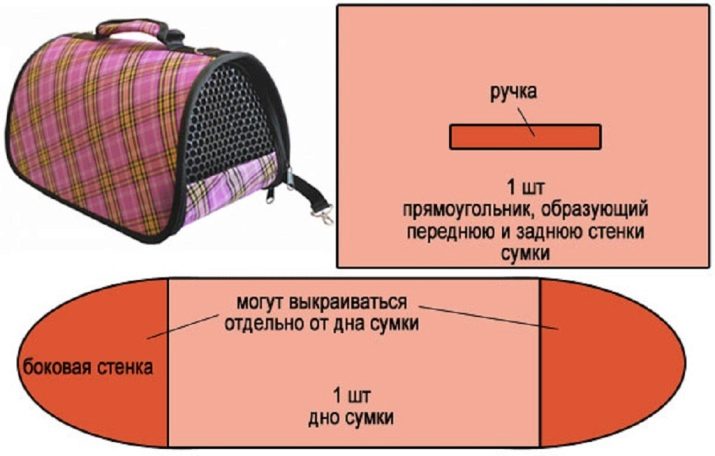
The self-created carrier can be used for short-term trips, emergency transportation of the animal. If you have to use such an accessory often, it is better to give preference to models with a rigid frame made by a well-known manufacturer.
For information on how to make a cardboard cat carrier, see the next video.
































